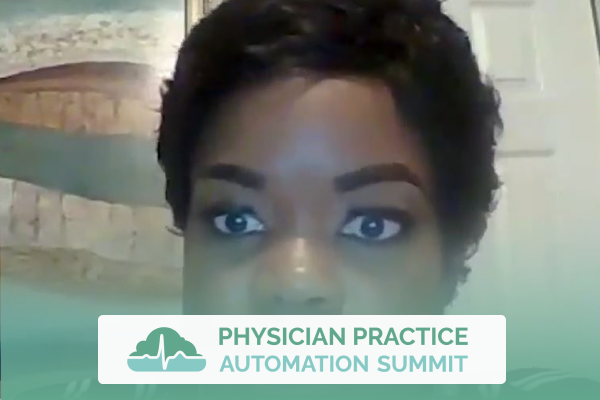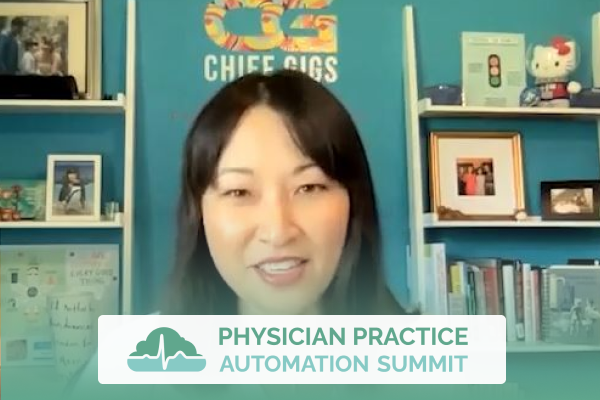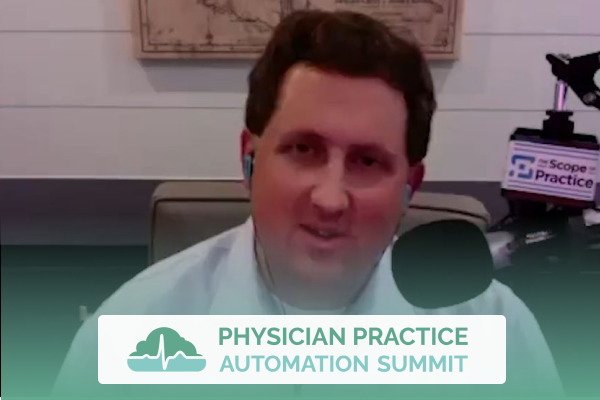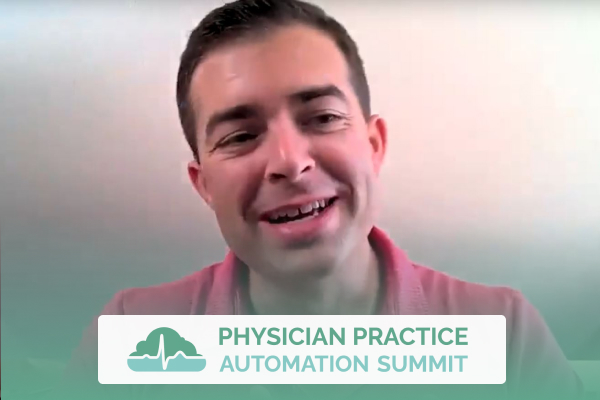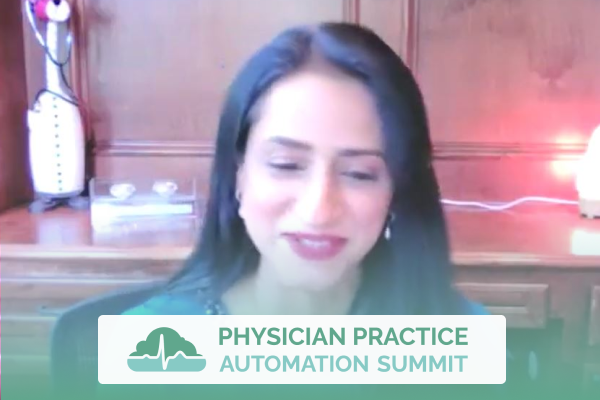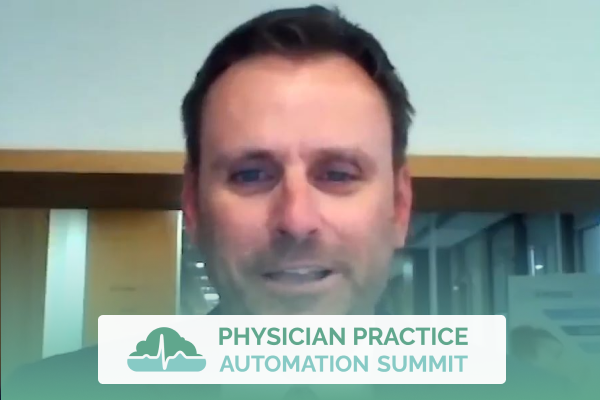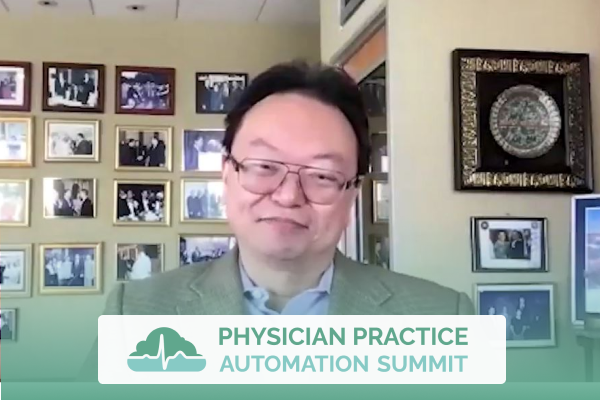Join the discussion below
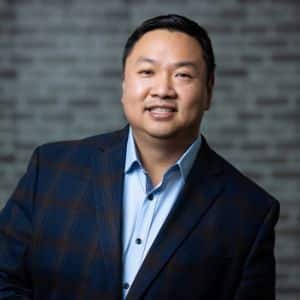
Dr. Ruan is the Founder and CEO of Texas Center for Lifestyle Medicine. He devotes his career in practicing and building systems that allow for efficient delivery of healthcare. He is a board certified internal medicine physician but also have advised with companies to improve their workflow, company culture, marketing,... Read More
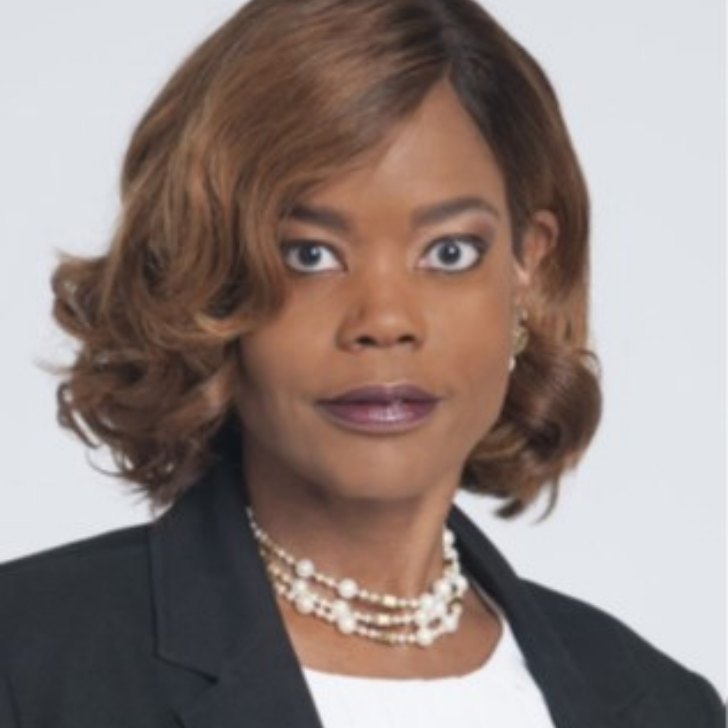
Tawny Jones-Mack is an accomplished Administrator at the Cleveland Clinic. She holds a Bachelor of Science, Master of Business Administration, and is in pursuit of a Doctorate in Healthcare Administration. For 19 years, she has served as a well-respected leader, managing patient concentric care initiatives, creating value, and delivering results... Read More
Cheng-Huai Ruan, M.D.
So awesome, welcome to the Summit. Thanks for being here.
Tawny Jones-Mack
Thank you, thanks for having me.
Cheng-Huai Ruan, M.D.
Yeah, so you know when when I first heard that Cleveland Clinic had a functional medicine program, I was actually pretty intrigued because at that time I actually didn’t even know what functional medicine was, so it was a few years ago. And then I also was very intrigued that a large institution would have something like this, that you’ve traditionally seen in smaller practices and cash based model practices. And so I know you’re sort of the wheels behind that, so I kind of want to just kind of poke your brain a little bit about how this was developed in the first place, and where is it now?
Tawny Jones-Mack
Yeah, so such a great genesis. Our beginning was amazing, our former CEO Dr. Cosgrove, Delos Cosgrove invited Dr. Mark Hyman to initiate the Center for Functional Medicine in partnership with the Institute for Functional Medicine, and together all entities started to put together a plan that would be patient centered, focused on chronic disease management, looking at the whole person, not just an isolated set of set of symptoms. You know, we wanted the opportunity for the physicians to spend time with their patient, listen to their stories, look at their personal timeline, and then really dig into the genetic, environmental, and lifestyle factors that were influencing their health and causing these chronic conditions and diseases.
And so we began the recruitment process of a team of certified physicians in functional medicine, in addition to our nutritionist and our health coaches. And this was October, we kicked off our first clinic October 2014. So you know, it doesn’t seem like a long time ago, but for us it has been a robust mission over the past few years, and it’s just been amazing. But we wanted to address diet, lifestyle, behavior change, and really hone in on this food as medicine approach, and help patients you know, move from this space of illness and sickness to a space of wellness. And so we have been able to do that over the past few years and have had huge successes, and the practice continues to excel and grow.
Cheng-Huai Ruan, M.D.
So that’s great. It seems like you have a lot of systems that set up, from health coaches to physicians, and then also share medical visits or group visits as well. And so you know, I actually used a lot before Cleveland Clinic had it, I actually built it into my own practice at the very beginning. And so, but let’s talk this because I think for a lot of like private practices the concept of shared medical visits outside of psychiatry is a bit foreign, but it’s also you know, it’s really questionable because how do you get patient buy-in into the process? What’s your experience with that?
Tawny Jones-Mack
Yeah, so the Cleveland clinic has actually been doing shared medical appointments since 1999. So not necessarily a new concept at the clinic, but what we really focused on is marrying this idea of medical management with social connection and letting the patients understand that in the amount of time you’re going to spend with your physician in a routine appointment, you’re not necessarily going to learn or gather all the tools and the insight to help you really achieve your highest expression of health. But our shared medical appointments are 10 weeks long, and over the 10 weeks there’s about 14 hours of curriculum built into that. And so what it means is each week, because these are weekly sessions, each week they get a full toolbox for their health that includes everything they need to know about self-management of their condition, what a whole foods dietary intervention is, the effects of nutritional deficiencies on their health, what stress management techniques are necessary for them to improve their health, how to develop healthy sleeping patterns, and then the power of movement.
And when you think about that, you know, you’re a physician and a great physician, but you don’t have time to really dig in deep with any patient in the amount of time you have in their clinic on a routine visit, because you’re trying to address so many different issues. So we figured you know, why not do what we do best? We have the medical management component down, but let’s try to bring in this lifestyle and behavior change, and start to address this, and really create this therapeutic partnership with the patient where you know, it’s not just us feeding them information, but it’s us gathering information from them, and them gathering information from each other, and everyone learning and growing together. And let’s do this in a way that helps them improve their health, it’s you know, not threatening, they don’t feel embarrassed or ashamed because they’re with other individuals who are you know, experiencing the exact same thing.
They may lack self-confidence when they start, they may feel embarrassed about their situation, or they may feel like I don’t want to ask the physician that, it’s intimidating, but in this group setting, you know, there there’s a sense of empowerment. Like “wow, I’m not in this alone”. You know, I have you know, I have the ability to get better, and there are other people here who will help me to do this. And you know, so the facilitators are there to really guide the conversation, but the real magic or the you know, the real alchemy of the program, it happens within that setting in the synergies that the patients develop.
We put the content where you know, in a way, or we develop and showcase it in a way that is very digestible and understandable for patients. And I think that’s important, because we think health literacy is automatic, and it’s not. You know, patients don’t necessarily understand terminology, the jargon that we’re using. They’re nodding in agreement, “yeah, I get it, uh huh sure, I’m gonna do everything you say”, until they walk out the door and they have to really process what it is you expect them to do. It’s a lot for any patient, you know, to digest the true impact of their chronic condition, but then also, “How do I manage it? How do I treat it? How do I get better?”. And we all know the power of a social connection layered on top of that medical management, the outcomes are just magnificent. So…
Cheng-Huai Ruan, M.D.
Yeah, let’s talk about the outcomes. Like I assume you guys gathered data on this, right?
Tawny Jones-Mack
We do, we do. And what we see just in general is about 64% of the patient, and we track promise, you know, the patient reported outcome measures, so on every patient. But they’re improved about 64%. Now we’re talking about a 10 week program of those patients improving their mental and physical health. There’s a weight loss, and sometimes patients aren’t coming for weight loss, but just inherent in the fact that they’re eating better, they’re moving, you know, they’re conscious about their health matters. You know, they’re starting to lose weight and get healthier. It’s about eight pounds over the 10 week period, about 49% of those patients lost 5% of their initial body weight that we saw.
We took a cohort of about 300 patients, almost 300 patients, and just really dug into their biometrics. And you know, everything just started to look at everything as a whole, and their blood pressure change was absolutely amazing. About, on average systolic blood pressure change, negative 7.3, and what was even more compelling for us is you know, we’re thinking 10 weeks, every week, people are just not going to show up. And we saw quickly that about 84% of those patients were attending five or more weeks of the program.
Cheng-Huai Ruan, M.D.
Wow, 84%, that’s a pretty high number.
Tawny Jones-Mack
Yeah, yeah it’s pretty high. So and you know, we were appreciative of the fact that they were that invested, that they would show up. And then people, I mean we had people traveling six seven hours every week to get to this program because they just didn’t want to miss. They felt like it was so hugely valuable that they did not want to lose the opportunity to be engaged in the class. And so when you stack that up against our conventional medicine models, which you know are great, you know, healthcare overall is great, but you don’t have the amount of time that you need, you don’t necessarily have the dietician and health coach right there in the clinic with you. You may not have time to address the stress related concerns. Many people feel intimidated by the clinical environment, and here we put you in this, you know, innovative delivery model of shared medical appointments where you have this whole team who’s invested, you have this group of peers who are invested, very supportive environment.
You care for each other, just inherent in the fact that you’re going through something life changing. You’re caring for each other, and you’re in your overall engaged. And then the providers can kind of sit back and facilitate and you know, they’re not as burned out, and they don’t feel like oh my gosh, I have to do this over and over again, why am I saying the same thing over and over again, duplicating efforts, being redundant? Why am I doing this? You know, and what we also found as we were collecting the data, it’s more cost-effective. And so if we have a minimum of six patients in this class, you know, which is not difficult for us to do at all, we usually have about eight to 10 patients. But if we have six patients in class, it’s actually more profitable for us to do this than for us to see patients one-on-one. And so you know, our recent recent publication in BMJ Open, you know, explained some of that, that may be of interest to some of the physicians.
Cheng-Huai Ruan, M.D.
Oh, absolutely. Actually, we’ll have that link in the description because I actually read that before we got on.
Tawny Jones-Mack
Yes, great, great.
Cheng-Huai Ruan, M.D.
So you had a break even point of between, I guess five and six patients, right?
Tawny Jones-Mack
Mm hm, mm hm.
Cheng-Huai Ruan, M.D.
And everything on that, it has has a profit margin to it, right?
Tawny Jones-Mack
It’s a profit, yeah.
Cheng-Huai Ruan, M.D.
And so who’s running these groups? Is it health coaches, or doctors, or is it both?
Tawny Jones-Mack
Yeah, so it it’s a combination of providers at certain intervals in the program.
Cheng-Huai Ruan, M.D.
Got it.
Tawny Jones-Mack
So you know, the physician certainly there’s no substitution for the medical management. These are chronically ill patients. We’re talking about digestive disorders, auto-immune, so you need that physician or that advanced practitioner, you need that knowledge and that experience, you may need to work with primary care to adjust medication, so these people come really sick, and you know, this is not a 10 weeks of play time, this is 10 weeks of intense learning, comprehensive learning, and really gathering the tools you’re going to need to manage your condition over the long term. If you don’t get, for some people getting better is all they have, you know, there’s no cure, but you have to have a you know, a quality of life that you’re comfortable with. So if we can help get you there, you know, this is what you’re here for.
So though they have a great time and you hear people laughing, you see people crying, you see the emotions, high-fiving, and you see everyone you know, actively engaged, it is very serious content. You know, we don’t, we’re not doing the one, two, threes, we’re digging into that hemoglobin A1C real deep, we’re digging into fatty liver concerns real deep, cholesterol, blood pressure, you know. We want you to know what the impact of these things will have on your overall health. So yes, the physician component, or the clinical medical management component of it I should say, is critical, and yes, that is heavily embedded in the sessions. But we start with our nutritional counseling is really our, is our therapeutic intervention. You know, we need to change the diet first and foremost.
Cheng-Huai Ruan, M.D.
Right
Tawny Jones-Mack
And so you know, if we will have to get you from crisis mode to resurgence there’s a way that has to happen. And that means you know, digging deep into that diet and making sure that you understand how what you’re eating is influencing you getting better or you getting worse. And so we are certainly heavy on that content. And then the health coach, you know, we certainly know that the value of sleep, and stress management, and movement, lifestyle and behavioral change is critical, so those providers are also involved. So we’re rotating those providers over the 10 weeks.
Cheng-Huai Ruan, M.D.
I see. Let’s talk about funding for a second. Are payers actually paying for these visits? And if so, are they also paying for the shared medical visits as well?
Tawny Jones-Mack
Yeah, shared medical visits are you know, still medical management. So they are absolutely you know, billed evaluation and management services, just like you would for you know, any other service rendered to a patient, so absolutely.
Cheng-Huai Ruan, M.D.
Okay, so that’s why you’re saying that if you have a five to six patient break even, then you’re spending that hour or whatever, and seeing those five to six patients, which basically seeing these patients, you know, in eight minute intervals if you will, right with regular physicians.
Tawny Jones-Mack
Yeah, right. And that’s what honestly, that’s what they individually, they get about seven to eight minutes with the provider, but that seven to eight minutes is not where the real education, teaching, learning is happening. It’s embedded in that overall curriculum, so that’s where we you know, focus our efforts and energy. Certainly you know, patients appreciate having that one-on-one time with the physician, but most of them are eager to get back into that classroom setting so that they aren’t missing critical information. And you know, they feel like “oh my gosh, hurry up so I can get back”, you know, get back to I do, what I’m doing best, so… And that’s learning how to manage my health.
Cheng-Huai Ruan, M.D.
I definitely want to reflect on that because you know, we’ve been doing group visits since the beginning at Texas Center for Lifestyle Medicine, but you’re right. There’s that let me go pee really quickly, but I don’t want to miss anything concept.
Tawny Jones-Mack
Right, right.
Cheng-Huai Ruan, M.D.
Because I think the energy and the dynamic is just so close knit, and there are those high fives, and there’s tears, and there’s revelations that come up. And a lot of our patients are forming like truly lasting bonds, even with each other. So we know the magic is there, and we know that there’s a revenue model, there’s a reimbursement structure from the payer model, but you also have health coaches? I think we were talking before how some of these patients we’re seeing, were maybe going into these shared medical appointments with health coaches beforehand, before they get seen by the one-on-one on the doctor’s side, right?
Tawny Jones-Mack
Yeah, yeah. And certainly, you know, health coaching thank goodness is, the payers are finally catching up to this idea that it’s a necessary component, and critical to the overall health of patients. And so reimbursement is starting to happen. We have not started collecting. In all honesty and transparency, we have not started collecting payments just yet. Our health coaches are in the process. You know, we’re going through the process, and hopefully we’ll have that taken care of here in the near future. But I am certainly glad that the acknowledgement that their services are critical to health is there, and the payers are starting to see that. So I feel very optimistic that we will see it, and hopefully in the near future do some research around the value of these health coaches in the clinical care model.
Cheng-Huai Ruan, M.D.
Oh, absolutely. So, but right now the patients aren’t paying for the, for the health coaches currently, right?
Tawny Jones-Mack
No, no.
Cheng-Huai Ruan, M.D.
Oh, they’re not?
Tawny Jones-Mack
So we have built that in as part of the service.
Cheng-Huai Ruan, M.D.
Oh I see, I see.
Tawny Jones-Mack
You know, the value of the over what they’re learning and gaining, you know, it outweighs right now, you know, asking a patient to pay. We don’t right now, things are cost prohibitive for a lot of people, we don’t want that to be a deterrent. And sometimes you know, you have to be creative in other ways to be able to gain the necessary revenue to keep things going. But we certainly are not billing patients for the health coaching services at this time, it is part of their overall care.
Cheng-Huai Ruan, M.D.
This certainly funnels into the core structure of the program, right?
Tawny Jones-Mack
Mm hm, that’s all. It is critical to the structure of the program.
Cheng-Huai Ruan, M.D.
No that’s great because–
Tawny Jones-Mack
You know, our goal is to help people reclaim their lives. And we understand that there are conditions and diseases that simply don’t have an end point. And so we have to teach them in a way that just simply makes sense, and that’s what the lifestyle and behavior change coaching, and overall health coaching does for them. It’s you know, teaching them in a way that’s real for them. You know, you can’t expect me to sleep eight hours a night if one, I’ve never done that, two, I don’t know how to prepare to do that. You know, I’m on my phone until two minutes before I go to sleep. So these are things that have to be taught. They have to understand all of this is important in that mission to reclaim their life.
Cheng-Huai Ruan, M.D.
Yeah, so let’s talk from the business side for a second. And for me, my brain always goes to decreasing the fixed and variable costs of practicing medicine. So I think that a lot of people were thinking, “oh my gosh, you have these health coaches, and they’re offering free services up front”. But I want people to understand that there’s a lot of value that we can really provide patients in the very beginning to actually reduce our costs later on.
Tawny Jones-Mack
That’s correct.
Cheng-Huai Ruan, M.D.
Because having a conversation with a patient that’s pre-trained takes a lot less time, especially from from the lifestyle metrics and integrative health and stuff like that. And also, there’s also FTE time, and the full time employee time that we have to take into account, because I know a lot of our patients, there’s just so many questions, kind of peppered in the beginning, it puts a time burden amongst the employees, and we have to triage those questions. And what you realize is 80% of them are the same freaking questions, so I think pre-training is a brilliant idea because it allows you to funnel targeted audiences into a system that was designed for that linearity. And so I think from the business perspective, it actually does make sense to have that funneling effect, pre-trains patients, less FTE time spent on triaging a lot of these questions that may not be necessary, that’s really easily trained. So I think we really have to rethink what the cost structure actually is when it comes to this, because it’s all about streamlining the revenue stream of the core value of the business. It sounds like you guys have done that, so that’s great.
Tawny Jones-Mack
Yeah, no, when you think about if I had my druthers, we’d have a health coach, probably multiple health coaches in every practice throughout any organization. And the reason I say that is if that health coach spends 30 minutes with the patient and frees up that physician who now only has to spend seven minutes, because the health coach is probably dealing with the other 30 minutes of issues, I just free that doc, that the doctor up to see how many more patients, so you know, you can do the math and think about that exponentially. And then when you put it in that perspective it’s you know, it’s like wow, wait a minute. You know, here’s a service provider, health coach who’s qualified, capable, competent dealing with issues that I spend as a physician, I spent so much time you know, physicians are thinking I’m spending so much time talking about these things, and someone else is more than capable of doing this, and now I can really invest in the chronic disease management component and really get them to understand why their hemoglobin A1C is not trending in the right direction.
You know, what they’re doing wrong and all of these other issues where we can really start to dig into that, and that could pass off what those concerns are to the health coach or to the dietician, and have them start to address it at that level. So it’s helpful people working for the top of their license. And when you do that the filling will automatically adjust accordingly. That’s the whole concept about working to the top of the license.
Cheng-Huai Ruan, M.D.
Yeah, working at the top of license, having the medical system’s employee work at the top of their training as well, right, and also you know, talking about, just thinking about how much I actually document during these patient visits. A lot of the documentation if they’ve seen a health coach first, which that’s our model as well, a lot of that’s already done, a lot of the nuances that are there, and I’m really just kind of cherry picking the things that I want to talk about, and execute on from the medical management side, right?
Tawny Jones-Mack
Right.
Cheng-Huai Ruan, M.D.
And then say “hey, good thing, you’ll follow up with your health coach on the back end as well”, or funneling them into a shared medical visit where we talk about much higher level things. You know, for example we have a whole COVID-19 vaccine explanation training thing that we do for share medical appointments. So already know that for this patient the diet part is already care of, we already talked about sleep, talked about meditation and stress management, and that funnels into our value that’s right here, and we can you know, go ahead and place them on a chain of delivering more value that’s downstream. I think medicine really needs to take this into account. Now if the people who are listening to this, and this is sort of my idea behind surgeons as well.
There’s a lot of people who are just very apprehensive about surgery. And so I know a few plastic surgery doctors who have coaches that walk them through the entire process a whole week before they even get to the surgery. Every day, seven days after, they check on them, make sure they’re doing okay, it’s a really high level of service. I think that there’s a way that we can do this outside of the primary care and surgical specialties, you know, pain management. I think there’s a lot of ways to really adapt this, but I think the entire structure is funneling targeted patient audience into a system where it’s not a huge burnout in pain points to practice medicine in this way, because there are pre-trained and then there’s multiple sessions follow up afterwards, right? I think that’s the beauty behind all this, right?
Tawny Jones-Mack
Yeah, no I absolutely agree with you. And it’s these wraparound services that improve the outcomes, both short term and long term. You know, it’s like you have this whole team approach, you have this multi-disciplinary group of individuals helping to support the patient through their journey. So it’s that upfront work, it’s that post you know, whatever treatment work that whether it’s surgery, post-surgical, per post medical treatment work, that is so important to the overall care. So yes, I’m in complete agreement with everything you’re saying.
Cheng-Huai Ruan, M.D.
Well, awesome. So I would imagine that ever since 2014, there has been pain points and learning points that you’ve gone through as well, right? Can you just kind of share with us what you really learned since the beginning of this journey, and to now, and how you guys kind of changed and pivoted to fit what it is right now?
Tawny Jones-Mack
Yes, so you know I’ve been with the clinic 21 years.
Cheng-Huai Ruan, M.D.
Oh wow.
Tawny Jones-Mack
So there’s been learning for me all along the way, but I will say that the most important things that have come from this model of care for this type of practice is the need for these wraparound services. And you know, I’ve worked in medicine, primary care, I’ve worked in surgery, orthopedic surgery, I’ve worked in infectious disease. I’ve been all over different areas throughout our organization, and have greatly appreciated every opportunity. But what I’ve learned of most significance in functional medicine is that, you know, without this next level of education, without this next level of intervention, we are going nowhere fast on chronic disease management. And when I you know, was in medicine and working with those groups, and I saw people coming in sick and discouraged, sick and discouraged and you know, had nowhere to go and nowhere to turn, and looked at staggering number of patients that were coming in and it just seemed hopeless, and didn’t have any sense of what direction they were going in. And we know the key drivers of a lot of this is modifiable lifestyle factors.
But what I didn’t see is a lot of nutrition counseling, and I didn’t see the health coaching component, and the you know, behavioral therapy component of it embedded in the care model. And so one of the most important things I learned is that those are critical care components that for some reason got lost in our, our new age of healthcare delivery, and it was concerning. So I was appreciative that you know, this functional medicine model of care was able to show, you know, showcase this in a way that was highly effective. And I see that more and more groups are starting to embed these extra services in their practice. I’d also say that you know, I was under the impression early on that patients would not embrace this model of care, you know, because we are creatures of habit, we know our doctors, we know what they do, we want to do the same thing over and over. And so I was a little bit reticent about this idea of having a clinic, and having services that people aren’t familiar with, and bringing it to this you know, magnificent organization, Cleveland Clinic, and things taking off. But I was pleasantly surprised.
I mean, we’ve had unprecedented demand for care, and I was happy to see that wow, patients really are eager to invest in their health, they really do want to get better. They are really looking for innovative care delivery models that will support them on their health journey. They really do want to eat better, they want to sleep better, they want to exercise, they want to contribute to society in different ways, and they’re not able to do that because of their health, and they want to learn how to do it. So I will say don’t underestimate the power of the patient. Definitely learn that, because I will say I was guilty of that. And then you know, don’t be afraid to take risks, you know, inherent in my personality, I’m a risk taker.
And so you know, I took this on and said you know, I’m going to be optimistic that with all the resources we have, and all of the support we have, that we can be successful, and we will be. And you know, we all work together to make sure that happens. So certainly you know, can’t be afraid to be a risk taker, and you know, get some negative feedback, but also get some positive feedback. You know, we were worried, what are people gonna think? And do they, are they concerned if you know, what we’re doing is legitimate? And are we supportive of you know, their existing treatment plans, all those questions that are naturally going to happen when you bring in a service into an organization that people aren’t familiar with. But you know, we took the risk and it served, certainly served to our advantage. And you know, we are doing very well as a practice. So don’t give up, I would certainly say don’t give up, get as much support from leadership as you possibly can, learn who your allies are, and you know, stay vigilant in what you’re doing, you know, stay focused on what we’re all here in health care for, the patient, the patient experience. So don’t lose sight of the mission.
Cheng-Huai Ruan, M.D.
Yeah, absolutely. So I think that whenever we build it, they will come. And talking about underestimating patients, we did too in the very beginning, cause we kind of kept our groups very small, and that lasted a week and a half. And then there were waiting lists for groups after a while, but then all that happened and then coronavirus hit, and we actually switched to virtual groups as well. And what we noticed is that when we switched to virtual, there was a lot less availability, we stopped for a while. People just keep on asking “Hey when can we do these group things again? Like let’s just get started again”. You know it’s, and you know what I realize is that for a lot of these patients, it’s literally the only safe place that they can go to in their lives, because when they go home they’re in a sea of demand, you know, they take care of the other people and stuff like that. And so this is–
Tawny Jones-Mack
Stressful, it’s you know…
Cheng-Huai Ruan, M.D.
Yeah.
Tawny Jones-Mack
And what we can’t risk is that stress becoming normalized. You know, we don’t want people to feel like they don’t have an outlet, you know, psychological distress, depression, all these are real, and they have a huge and negative impact on people in general, especially people who are suffering with any type of chronic condition. So we can’t get to the point where they don’t have an outlet. And I think this group model, relay to your point, really gives them that outlet, that’s why they’re so eager, that’s why they show up. That’s why they’re so eager to engage in it, because this is their you know, their time.
Cheng-Huai Ruan, M.D.
Yeah, absolutely. And so let’s talk about coronavirus for a second, cause that kind of stirred the pot for everyone, I think. But how has that really affected the Cleveland Clinic Functional Medicine program, and what have you guys done to date for stuff like that?
Tawny Jones-Mack
Yeah, we’ve certainly migrated to the virtual platform. Fortunately, we were already offering virtual appointments, but you know, I will say we pivoted very easily to a full-time virtual during the you know, the heightened areas of COVID. And right now we’re seeing about 60% of our patients virtually, about 40% in person. And we’re slowly but surely adjusting, adjusting to what we were before, more like 30, you know, 30, 70. So 30% percent virtual and 70% in person. So we’re slowly but surely going to get back there as things improve, but we have leveraged the virtual technology to engage with patients, and what we’re seeing is they’re really eager to understand what foods are the best, you know, to eat, to keep their immune systems strong and healthy.
And so our dieticians have been exceptionally helpful in guiding, you know, guiding patients during this time, the distress levels, as I said, you know, before, the stress levels and the psychological impact of what this has done to so many people, so many families, so many households. The health coaches are busier than ever trying to ensure that the patients, you know, feel like they are supported. We have behavioral therapy, we have a licensed social worker as part of our practice, and her referrals. Like we’re literally funneling to other areas throughout the organization because she’s so busy helping the people deal with the trauma that has come, you know, has resulted from COVID.
Cheng-Huai Ruan, M.D.
Wow.
Tawny Jones-Mack
It’s really helped us to expand our services. You know, we don’t want to undervalue the power of the social support, so we still have our virtual shared medical appointments, but our one-on-one appointments have been just as important, you know, during this time. So we have seen, you know, a good balance of both of those over the past several months. We have now a post COVID, what we call reCOVER SMA. You know, we don’t want patients to get better, or you know, once they are recovered from COVID not feel as if they don’t have a support system, so we have this reCOVER SMA that they can go into, and dig in a little bit deeper as to you know, what they should be eating to keep themselves healthy, and you know, how to monitor health issues that they might be having as a result of getting COVID.
Cheng-Huai Ruan, M.D.
So these are for the people who have had COVID, right?
Tawny Jones-Mack
Yeah, yeah, yeah, reCOVID, yep.
Cheng-Huai Ruan, M.D.
Oh, okay, okay.
Tawny Jones-Mack
And so you know, they’re recovering.
Cheng-Huai Ruan, M.D.
And so what’s SMA, what’s SMA stand for?
Tawny Jones-Mack
Shared medical appointment, I’m sorry.
Cheng-Huai Ruan, M.D.
Oh okay, thank you, sorry about that, okay.
Tawny Jones-Mack
So you know, those individuals are coming together, you know, after they’re feeling better, and we’re seeing them virtually, and outcomes, you know, preliminary outcomes are very consistent with what we’ve seen in the other shared medical appointments. Overall, their health is getting better as they’re struggling, you know, to really get over the impact of having COVID, and that’s physically and mentally get over that is what I’m suggesting.
Cheng-Huai Ruan, M.D.
I think the impact just started.
Tawny Jones-Mack
Yeah, yeah, yeah. You know, so people were at different points, you know, some people early on were plagued with COVID and you know, they just had a slow recovery process, and some people are just new, you know, recently got into the program, you know, recently are recovering from COVID. So people are at different places, but the important thing is that they you know, have this service, they have this shared medical service, and this group of individuals who certainly just went through exactly what they went through, and now they have resources and tools to help them, you know, reconnect and get their health back on track.
Cheng-Huai Ruan, M.D.
Well that’s great. I mean with what coronavirus has given, the opportunity of us leveraging technology, because I think there’s a higher adaptation of technology, especially in the elderly population, that we would not see before.
Tawny Jones-Mack
Yep, no for sure.
Cheng-Huai Ruan, M.D.
Yeah, I think and now that, and of course there were major CMS rule changes during the coronavirus, especially the middle part of 2020, saying now you can do this now in telemedicine, and I think–
Tawny Jones-Mack
Yeah, prescription management, everything, you can do everything.
Cheng-Huai Ruan, M.D.
Yeah. And I’m in Texas, and even our medical board actually allowed you know, electronic prescriptions for those people with long-term narcotics and stuff like that. And it allowed us to develop a system and program for us to help taper them, because you know, I really underestimated the patients, our own core patients, because what I was really seeing, and towards the beginning of COVID is that yes, people’s A1C were getting worse, and their blood pressures were getting worse, which I think we were seeing in the regular primary care sector within Houston. But with ours there was just a huge number of people, cause we also have free online programs for patients for auto-immune and diabetes, our online program they’re free, they just blew up.
And I think that when people were more engaged online, and that was actually our funnel, our funnel is actually online programs. And when they came in and all of a sudden they were showing these, the biggest changes that they’ve had in their life, because they saw coronavirus as a stimulating factor for change. And then what really happened is that it really allowed us to take a seat back and say okay, well these patients are doing a lot of these things, and for changing, and what it really allowed us to do is kind of re-engineer what the public really needs. And this is, I think very few medical practices do this, and I encourage them to do it. Like go ask the patients what they really want. So we asked the patients what they really want, and they’re like “hey, why don’t you have a vaccine education thing?”. I’m like “okay, we can totally do that”, you know?
Tawny Jones-Mack
Yep.
Cheng-Huai Ruan, M.D.
And I think that when this became a really big partnership during the coronavirus for a lot of practices, I think modeling after like understanding what the patients want, and not assuming, but asking them is a huge factor in this. Like you said earlier, get negative feedback and get positive feedback. So I tell my team, I was like “I don’t, you know, get your positive feedback, we’re going to celebrate that. But we want as many negative feedback, and as deep as it goes so we can have the patients partner with us”. And that’s when we learned the absolute most about our entire structure that we are usually blind to, and then one of the patients picks it up, and that’s what we want to know. And I feel like a lot of doctors may want to be blind to that part because it’s not a great feeling when you first learn about it, but at the same time, if you’re asking for it becomes let the patient be the partner. And I think that’s the what’s great about integrative health in general.
Tawny Jones-Mack
Yes, absolutely.
Cheng-Huai Ruan, M.D.
Is the partnership aspect, right?
Tawny Jones-Mack
It is that partnership, and we certainly see the value of that. And that, and they have such a strong partnership that they feel confident enough to have some self-management skills along with it.
Cheng-Huai Ruan, M.D.
Oh, absolutely.
Tawny Jones-Mack
So you know, there are far more patients than there are physicians. So we you know, once we build that therapeutic partnership and we have them confident, we want them to start to say okay, now I know exactly how to deal with this, now I know where to get the right information, now I know how to dissect this information that they have available online. I know what you know is, I should be looking at, or what I shouldn’t be looking at. So all critical to the long-term gain of what you know these patients are looking for.
Cheng-Huai Ruan, M.D.
Oh, absolutely. Now that we know about the patient side, and I’ll close with this question. Now tell me about the physician’s perspective, the practitioner’s perspective that work within the facility. What is their impression of this whole system? How are they kind of receiving all this? Because it’s relatively new as well for them, I’m sure.
Tawny Jones-Mack
Yeah, so you know, it’s a loaded question because the physicians, you know, I can talk about the shared medical appointment, and I can also talk about, you know, the group visits, but I can also talk about their overall experiences in trying to manage this, you know, and in functional medicine we are very collaborative and work very closely with you know, many other areas throughout the organization. So I think what it does for our physicians is it gives them an opportunity to you know, showcase what they do best, but also partner and learn from some of the other specialty areas on what patients need. And so it just further expands this whole integrative model and collaborative approach to care.
That is so important. So I will say that I feel like the physicians are very appreciative of the fact that you know, we specialize in what we do, but they specialize or what they do, but together, you know, we give this patient an overall amazing experience. In the group model, you know, it’s nirvana because you know, you’re improved patient literacy, you’re in a relaxed environment, there’s peer to peer sharing, they’re eliciting information from each other that you won’t get in your office, you’re able to learn from the patients’ stories, patients are able to learn from each other’s stories, they motivate each other, you know, you don’t have the issue of burnout, the gratification that you get is immediate. So our you know, our physicians, they love facilitating the shared, you know, the group model. They appreciate that it’s an environment where they don’t have to be so formal and starch, and you know, they can be relaxed, and they can kinda let their hair down, and let the group just talk, and you know, kinda guide them into thinking in the right way.
So from that standpoint, I think you know, many of them will say they almost prefer that model of care. And our group is actually looking at okay, how do we get more patients into more condition specific groups, or you know, more focused groups so that we can address more people than what we’re doing now. We keep a waiting list. There’s never a time we don’t have hundreds of people waiting to get into our practice, but you know, the physicians carry that burden, like okay, I can’t get my patients back in, but through the group model they can. And so they are always thinking about well hey, should we be leveraging these opportunities to build more groups to really you know, support patients in this way, and they’re always thinking about that. So it’s a great group of physicians, highly motivated, very interested in growing and thinking differently about care delivery models. And I’m appreciative to have the opportunity to work with them and you know, and then also to be able to collaborate with all those physicians throughout the organization.
Cheng-Huai Ruan, M.D.
Yeah, and I do reflect that too, but there’s very few things that are actually better than right after you finished your group session from a physician standpoint.
Tawny Jones-Mack
Mm hm.
Cheng-Huai Ruan, M.D.
And then there’s like you said, it’s this nirvana is because not only is there buy-in, there’s also really great feedback. You have the dynamics of a group that’s able to really validate each other, you know?
Tawny Jones-Mack
Yep.
Cheng-Huai Ruan, M.D.
And so I think that as we move along, when we think about health, I think we really have to redefine the role of what a physician really is, and like in your case with your physicians over there, is that hey, I’m a physician, but I’m also an educator, I’m a guide, and I can function as that in the group model. But at the same time as a one-on-one, I’m a physician, I do you know, disease management and stuff like that, but I get to practice at the top of my license because I have all these other resources to tap into, plus I have my own resource to tap into, cause I know I’m running another group the next week. And so you know, it’s really easy to say hey, you know, I’m doing my auto-immune class next week, why don’t you come into that, I think it’d be a lot of fun. And so, and it truly is, it truly is a fun situation once you keep it kind of lighthearted, and it’s not you know, it’s not designed to be like a lecture, and patients fall asleep, and that’s not usually what happens during these.
Tawny Jones-Mack
No, no, no, no, no, no, no. It’s so engaging, and you know, when it boils down to its simplest form it’s we do need to be creating coordinated and accessible and comprehensive care strategies for these patients, but we need to do it in a way that will entice them to engage in it and come back and be a part of it. And you know, hospitals, doctor’s office, medical offices, these are the areas that have the power to really hone in on these types of care models, and bring patients in the door, and get them healthy and start you know, to promote health, and all those things that’ll drive patients to just do better by themselves, do better by their families, do better by their communities. And so you know, let’s take charge and let’s do it. And that’s my mindset, it’s always my mindset. You know, let’s make it easy for them to want to do this, and let’s give it to em’.
Cheng-Huai Ruan, M.D.
Yeah. Do you think that this you know, you’re talking about a study in Cleveland clinic, do you think that this type of model could be replicated within you know, smaller physician communities and private physician practices?
Tawny Jones-Mack
I think it should be. It absolutely can be, but I think it should be. I think that we certainly need to start thinking very differently, and innovating around what we have historically known as you know, the healthcare model. How do we expand that? How do we grow that? How do we make sure patients are getting exactly what they need at the intervals that they need it? You know, the beauty of the shared group experience is we don’t dump all of the information on the patient in the first visit. You know, we slowly dose that to them, just like you would medication, we dose it to them over a period of time. And then you know, look at wow, they actually retained it, they are actually getting it, they’re able to apply what we’ve taught them, versus just giving them everything at once, and it’s like you know, good luck, here you go. You know, let me know, I’ll see you a month, six weeks, eight weeks from now, and let me know how that went for you. We’re to a certain extent, we’re holding their hand through the process until they’re comfortable to be free to manage it themselves. And so all of that’s critically important, and certainly from my perspective, the way of the future, you know, supporting all these wraparound services, supporting them. So yes, it should be, not whether or not it could be. It absolutely should be how we move, you know, as a society, as a community as healthcare partners it should be how we move.
Cheng-Huai Ruan, M.D.
Well excellent. We’ll be looking forward to more data that you guys put out, and use that as a backbone, and actually approach our own payers within our local communities to say hey, this model works. This is the you know, the promise score, what Cleveland Clinic has shown and stuff like that. So I think it’s time for physicians to really step up and do the things that we really want to do. If we feel like this model actually works, collect the data, say that it can potentially work, and then and then go for it and take that risk, a hundred percent onboard with you there. So thank you very much.
Tawny Jones-Mack
Thank you, no thank you. It’s been an honor to be a part of the Summit, so thank you.
Cheng-Huai Ruan, M.D.
No, it’s my honor. So for those docs out there, think. You know, I want you to just kind of think about what a medical practice is, and maybe that there’s some limiting beliefs that we have, what it should be, and potentially if you want to adopt the Cleveland Clinic model, might be able to think about how that could work within your private practice structure. So thank you very much. Thank you Tawny for coming on. We’ll sign off, thank you.
Tawny Jones-Mack
Thank you.
Downloads

